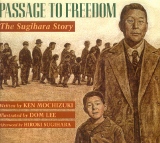|
Passage to Freedom

Last updated Thursday, July 16, 2009
Author: Ken Mochizuki
Date of Publication: 2003
ISBN: 1880000490
Grade Level: 3rd (GLCs: Click here for grade level guidelines.)
Date(s) Used: Jun. 2009
Synopsis:
"If you save the life of one person, it is as if you saved the world entire." This was the exact sentiment of the Japanese diplomat, Sugihara, and his family in Lithuania in 1941. Contrary to government orders, he issued thousands of visas to Polish Jews who became Sugihara survivors and kept their worn pieces of freedom papers as family treasures. For his selfless acts of kindness, Sugihara received the "Righteous Among Nations" Award and in Yaotsu, Japan, the Hill of Humanity is named in his honor. The Sugihara story is brief and concise, but strong and emotional. It is a story of strong belief in doing what is compassionate and right regardless of the consequences. The strong emotions emerge from the dramatic reading and interpretation by Ken Mochizuki. Children will relate to the feelings of Hiroki, the eldest son, from whose eyes the story is narrated. Respect for family, sensitivity of others, and honor toward parents emanate from the narration. Language differences when the Polish children arrive never make a barrier in play or in empathy. Listening to the story is even more dramatic than reading it. The "Afterword" adds authenticity to the story and brings the entire episode to closure. After listening, teachers can lead discussions about World War II, life-altering decisions, selflessness, compassion, and racial prejudice. This story of honor, love, and compassion presents a view of history that is seldom found in history book. It should be purchased by every public and school library.
| Note to readers: |
| • |
Note: Read the Afterword in the back of the book which describes what happened to Mr. Sugihara after he wrote the visas.
|
| Discussion topics for before reading: |
| • |
Where do you think the people on the front cover are from?
|
| • |
Can you pronounce “Sugihara”? (Su-gee-har-a )
|
| • |
What country is Mr. Sugihara from (Japan)?
|
| • |
Where is Japan? Where is Lithuania? Where is Germany?
|
| Discussion topics for during/after reading: |
| • |
What is an Ambassador? (A person sent by one country to live in another as that country’s representative).
|
| • |
Are there embassies in Los Angeles? (Yes)
|
| • |
Why did Mr. Sugihara want to write the visas? (To help the Jewish people escape imprisonment/death by the Nazis).
|
| • |
Would you write the visas when your country said no?
|
| • |
What do you think happened to Mr. Sugihara and his family? (Read the Note in the back for what happened).
|
| • |
Why didn’t Mr. Sugihara allow his wife to write the visas when she offered? (To protect her from death or imprisonment for violating Japan’s orders).
|
| • |
How would you have helped your dad in this situation?
|
| • |
Was Mr. Sugihara a hero? Why?
|
| Craft ideas: |
| • |
Make a Passport which would allow you to travel to every country. Take several sheets of white copy paper and cut in half (hamburger style). For the passports cover, take a piece of construction paper and cut in half (hamburger style). One sheet of construction paper will make 2 passports. Place the white paper on top of one of the half sheets of construction paper and fold all the sheets in half to make a book. Staple the folds to secure. On the cover of the passport write PASSPORT and the country you live in (United States of America). Draw a large circle and then draw symbols of America–the flag, stars/stripes, eagle etc... On the first page of the passport, write your name, address, birth date, and person to contact in an emergency. On the following pages write VISA on the top. Decorate each page with the name of the country you wish to visit and a picture of something from that country–their flag, a monument (Eiffel Tower, Pyramids), an animal/flower etc... Use the globe to discover new countries you want to visit when you are older.
|
| • |
Draw your own visa and make it into a paper airplane.
|
| • |
Make a Father’s Day card.
|
*Note: These craft ideas are just suggestions.
You can use them, but you don't have to use them.
You can expand upon them, or add your own twist.
Remember, though, that the focus of your time should
not be on the development and execution of a craft;
the focus should be on the read-aloud and the
enjoyment of the book!
|
